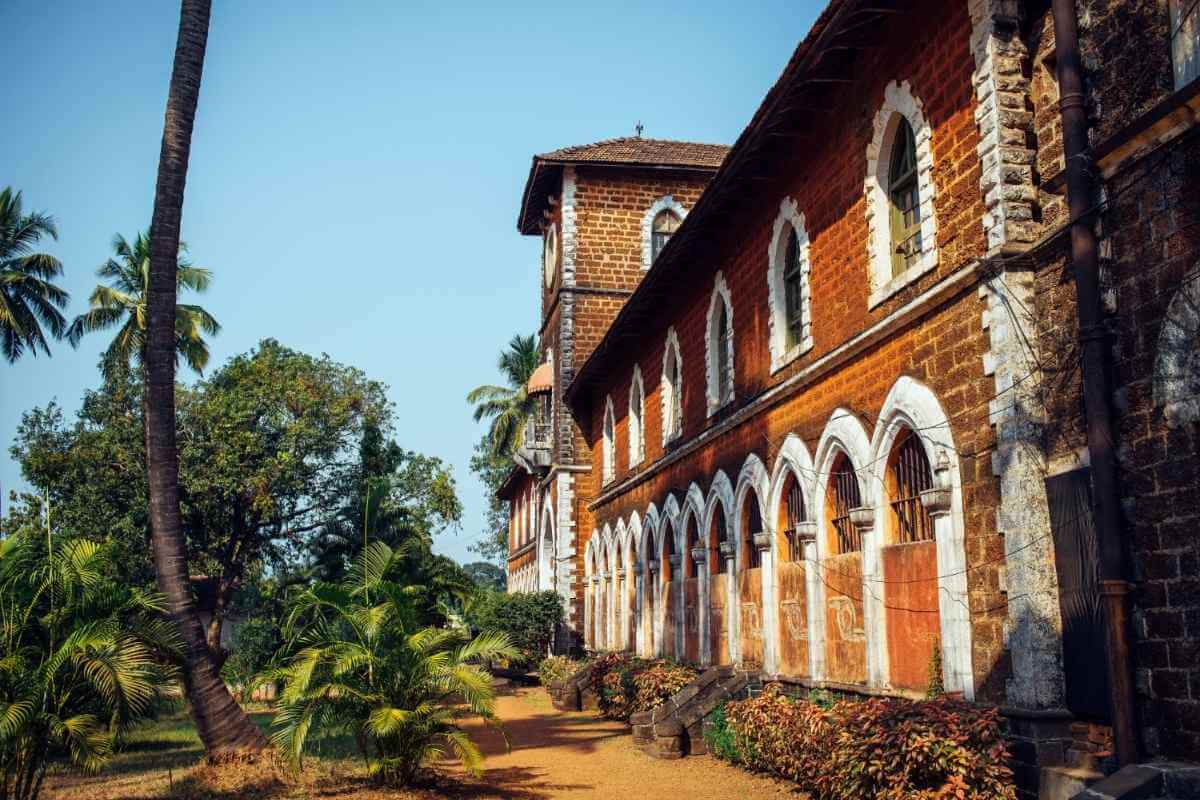Goa, a small state located on the western coast of India, is known for its sandy beaches, vibrant nightlife, and unique blend of Indian and Portuguese culture. However, what many people may need to realize is that Goa is also home to an impressive array of UNESCO World Heritage Sites, which highlight the state’s rich history and cultural diversity.
In this article, we will explore the seven world heritage sites recognized by UNESCO in Goa, including their historical and cultural significance, and what makes them so special.
From the stunning Baroque architecture of Old Goa to the breathtaking natural beauty of the Western Ghats, each of these sites is a testament to the unique cultural heritage of Goa and the Indian subcontinent as a whole
1. The Basilica of Bom Jesus
The Basilica of Bom Jesus is a UNESCO World Heritage Site located in the state of Goa, India. It is a Roman Catholic church that was built in the late 16th century and is one of the most famous and revered churches in India. The church is famous for housing the mortal remains of St. Francis Xavier, a Jesuit missionary who played a significant role in spreading Christianity in India during the 16th century. St. Francis Xavier is considered one of the greatest Christian missionaries and saints in the Catholic Church, and his body is displayed in a silver casket inside the church.
The Basilica of Bom Jesus is a prime example of Baroque architecture in India, and it features an elaborate facade and interior decoration. The church has a simple exterior that is decorated with intricate carvings and reliefs, while the interior is adorned with ornate altars, paintings, and sculptures. The main altar of the church is dedicated to St. Francis Xavier, and it is decorated with several statues and carvings that depict scenes from his life. The church also has several side altars dedicated to various saints, including St. Anthony of Padua and St. Ignatius Loyola. Visitors to the Basilica of Bom Jesus can also explore the adjacent museum, which houses a collection of artifacts related to the history of the church and its role in the spread of Christianity in India. The museum also has a section dedicated to the life and work of St. Francis Xavier.
Overall, the Basilica of Bom Jesus is an important religious and cultural landmark in India, attracting thousands of visitors every year. It is a testament to the rich history and religious heritage of Goa and the significant role played by the Portuguese in shaping the region’s culture and architecture.
2. The Historic City of Panaji
The historic city of Panaji, also known as Panjim, is the capital city of Goa, a state in western India. Panaji has a rich history, dating back to the 16th century when it was founded by the Adil Shahi dynasty. Over the years, the city has been ruled by various dynasties and colonial powers, including the Portuguese, who occupied Goa for over 400 years.
One of the most notable historical structures in Panaji is the Adil Shah Palace, which was built in the 16th century by the Adil Shahi dynasty. The palace served as the residence of the Adil Shahi rulers, and later became the official residence of the Governor of Goa. Today, the palace is a popular tourist attraction and a significant symbol of the city’s rich cultural heritage.
In addition to the Adil Shah Palace, the historic quarters of Panaji are also of great cultural and architectural significance. The city’s narrow streets, old buildings, and traditional Portuguese-style houses are a testament to its colonial past and the blending of different cultures over the centuries.
Many of the buildings in Panaji have distinctive Portuguese-style architecture, with ornate balconies, tiled roofs, and bright colors. The city’s historic quarters are also home to several churches and other religious structures, including the Church of Our Lady of Immaculate Conception, which is one of the most iconic landmarks of Panaji.
Overall, the historic city of Panaji is a fascinating destination for anyone interested in history, culture, and architecture. Its a rich heritage and unique blend of different cultural influences make it a truly unique and captivating city.
3. Reis Magos Fort
Reis Magos Fort is a 16th-century fort located in Verem, a village in the state of Goa in western India. The fort was built by the Portuguese in 1551 to protect their territory from enemy attacks, and it played a crucial role in defending the northern side of the Mandovi River. The fort was named after the Three Wise Men or Magi, who are believed to have visited the baby Jesus in Bethlehem.
The fort was strategically located on the northern bank of the Mandovi River and provided a commanding view of the Arabian Sea. Over the centuries, the fort underwent several renovations and upgrades to keep up with changing military requirements.
Today, the Reis Magos Fort has been restored and converted into a cultural centre and museum. The fort offers panoramic views of the Mandovi River and the Arabian Sea, making it a popular tourist destination. Visitors can explore the various sections of the fort, including the ramparts, bastions, and watchtowers.
The cultural centre at the fort offers a range of events and activities, including exhibitions, music concerts, and art shows. The centre aims to promote the culture and heritage of Goa and showcase the artistic talent of local artists.
The museum at the fort houses a collection of artefacts and exhibits related to the history of Goa, including weapons, armour, and other military equipment used by the Portuguese. Visitors can also learn about the cultural and artistic traditions of Goa, including music, dance, and cuisine.
Overall, the Reis Magos Fort is a fascinating destination that offers a glimpse into the rich history and culture of Goa. Its location on the banks of the Mandovi River, its panoramic views of the Arabian Sea, and its cultural and artistic offerings make it a must-visit destination for anyone visiting Goa.
4. Shri Mangeshi Temple
Shri Mangeshi Temple is a Hindu temple located in Priol, a village in the Ponda region of Goa, India. It is one of the largest and most important temples in the state and is dedicated to Lord Mangesh, a form of Lord Shiva. The temple is known for its unique architecture, religious significance, and its role in the cultural life of Goa.
The temple has a rich history, dating back to the 16th century when it was first built. It underwent several renovations and expansions over the years, and the current structure dates back to the 18th century. The temple’s architecture is a blend of Hindu and Portuguese styles, with a white tower and dome that are reminiscent of European churches.
The temple complex is spread over several acres and includes a main hall, a sanctum sanctorum, a large water tank, and several smaller shrines. The sanctum sanctorum houses the main deity, Lord Mangesh, and is considered one of the holiest places in Goa. The temple also has several other deities, including Lord Ganesha, Lord Vishnu, and Goddess Parvati.
The temple is an important pilgrimage site for devotees of Lord Shiva, and several festivals are celebrated here throughout the year. The most important festival is the Shivaratri festival, which is celebrated with great enthusiasm and devotion. During the festival, thousands of devotees from all over Goa and beyond visit the temple to seek blessings from Lord Mangesh.
Overall, the Shri Mangeshi Temple is a significant religious and cultural site in Goa. Its unique architecture, religious importance, and role in the cultural life of Goa make it a must-visit destination for anyone interested in exploring the history and traditions of the region.
5. The Aguada Fort
The Aguada Fort is a historic Portuguese fort located in the state of Goa, India. Built-in the early 17th century, the fort was a strategic military outpost for the Portuguese in India and played an important role in defending their colonial interests in the region. In 1986, the Aguada Fort was designated a UNESCO World Heritage Site as part of the “Churches and Convents of Goa” ensemble, which recognizes the unique blend of Indian and European architectural styles that developed in Goa during the colonial period.
The fort is located on the Aguada beach and is surrounded by a moat and ramparts that were designed to protect it from attack. The fort is spread over a large area and contains several buildings and structures, including a lighthouse, barracks, and a water tank that could hold up to 2,376,000 gallons of freshwater. The Aguada Fort is notable for its unique blend of Indian and European architectural styles. The fort’s walls are made of laterite stone, a local building material that was widely used in Goa during the colonial period. The fort also features several architectural elements that are typical of Portuguese military architecture, such as gun turrets, battlements, and loopholes. The fort played an important role in the history of Goa and witnessed several battles and conflicts during its long history. It was used by the Portuguese as a base for their naval operations in the region and played a key role in the defense of the Portuguese colonies in India.
Today, the Aguada Fort is a popular tourist attraction in Goa and is visited by thousands of visitors each year. The fort offers stunning views of the Arabian Sea and is a popular spot for watching the sunset. It is also a popular location for film shoots and has been featured in several Bollywood movies.
6. The Se Cathedral Church
The Se Cathedral is a 16th-century Catholic cathedral located in Old Goa, a historic city in the Indian state of Goa. It is one of the largest churches in Asia and is renowned for its architectural grandeur, intricate carvings, and historical significance. In 1986, the Se Cathedral has declared a UNESCO World Heritage Site as part of the Churches and Convents of Goa. The Se Cathedral was built to commemorate the victory of the Portuguese over the Muslim army in the Battle of Diu in 1509. Construction began in 1562 and was completed in 1619, taking over 50 years to build. The cathedral is dedicated to St. Catherine of Alexandria, a Christian martyr who was beheaded by the Roman emperor Maxentius in the 4th century.
The Se Cathedral is an outstanding example of the Portuguese-Manueline style of architecture, which combines elements of Gothic and Renaissance styles with Portuguese decorative motifs. The cathedral has a cruciform plan, with a nave, transept, choir, and sanctuary, and is adorned with ornate altars, statues, and paintings. One of the most notable features of the Se Cathedral is its bell tower, which stands at 46 meters (151 feet) and is one of the tallest in Asia. The tower is topped with a distinctive cross that can be seen from miles away and is a symbol of the region’s Christian heritage.
The Se Cathedral is also home to several important relics and artworks, including the Golden Bell, which is the largest bell in Goa and is said to be audible up to 10 km away, and the Chapel of the Blessed Sacrament, which houses a tabernacle that is made of pure gold.
Overall, the Se Cathedral is an important cultural and historical landmark in Goa and is a testament to the region’s rich architectural and religious heritage. Its designation as a UNESCO World Heritage Site underscores its significance as a cultural treasure that must be preserved for future generations.
7. The Chapel of St. Catherine
The Chapel of St. Catherine is a UNESCO World Heritage Site located in Old Goa, India. It is one of the oldest and most historically significant churches in the region and is renowned for its architectural and artistic excellence. The Chapel was built in the early 16th century by Portuguese colonizers, who arrived in Goa in 1510. It was dedicated to St. Catherine of Alexandria, a 4th-century Christian martyr, and was originally used as a chapel for the Franciscan friars who accompanied the Portuguese on their journey.
The Chapel is known for its simple yet elegant architecture, with a cruciform plan and a barrel-vaulted roof. It is made of laterite stone, a common building material in the region, and is decorated with intricate floral motifs and carvings. The interior of the Chapel is equally impressive, with a high altar adorned with richly carved and gilded woodwork, and a number of paintings and statues that reflect the influence of European art and culture on the region. The Chapel is also home to a number of historic artefacts, including a 16th-century ivory casket and a silver processional cross.
The Chapel of St. Catherine is significant not only for its architectural and artistic value but also for its historical importance. It is a testament to the early Christian presence in Goa and the role played by the Portuguese in the spread of Christianity in India. The Chapel is also a symbol of the cultural and religious diversity of Goa, which has been shaped by centuries of interaction between different peoples and civilizations.
Overall, the Chapel of St. Catherine is a fascinating and historically significant site that provides a glimpse into the rich cultural heritage of Goa and the broader Indian subcontinent. Its designation as a UNESCO World Heritage Site recognizes its importance as a unique and valuable cultural asset that should be preserved for future generations.
In conclusion, Goa is a state in India that boasts a rich cultural and natural heritage. Its status as a former Portuguese colony has left an indelible mark on its architecture, cuisine, and way of life, and its natural beauty is unrivalled. The recognition of seven world heritage sites by UNESCO is a testament to the importance of preserving these sites for future generations. From the stunning churches and convents to the spice plantations and Dudhsagar Falls, each of these sites offers a unique glimpse into Goa’s rich history and culture. The Basilica of Bom Jesus, in particular, stands out for its importance as a religious and cultural landmark that attracts visitors from around the world. Overall, the recognition of these world heritage sites in Goa serves as a reminder of the importance of preserving our cultural and natural heritage for future generations to enjoy.


























